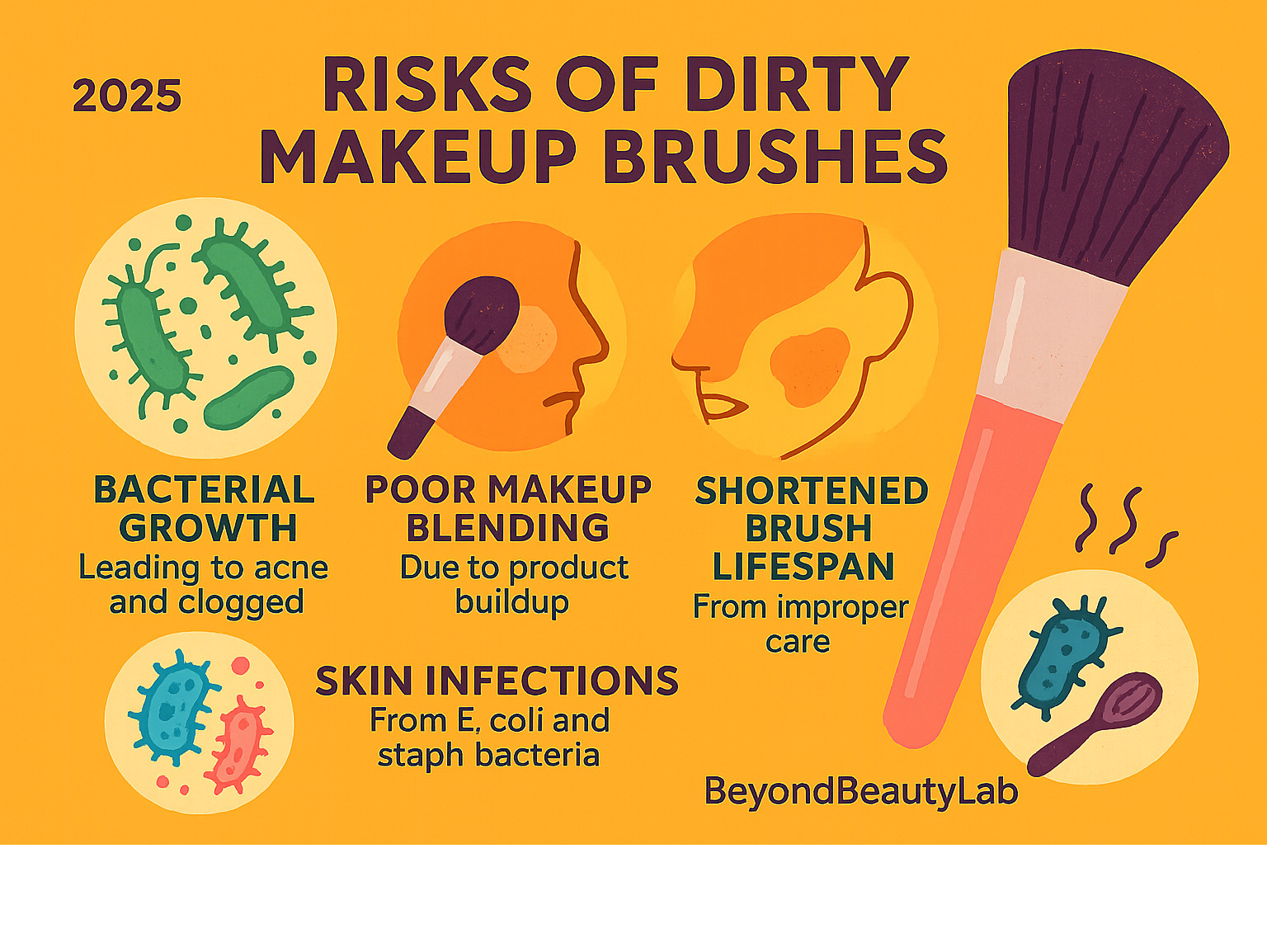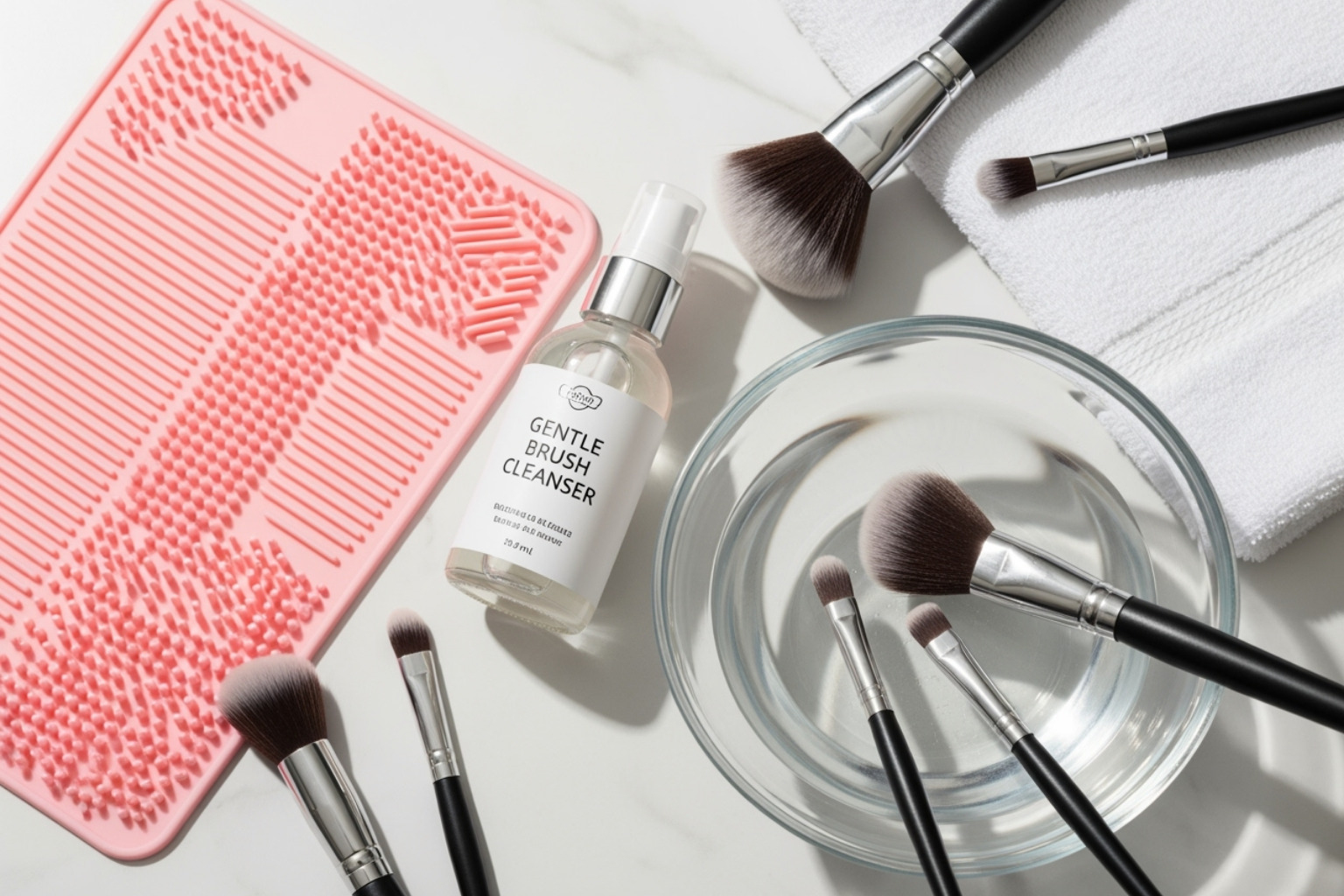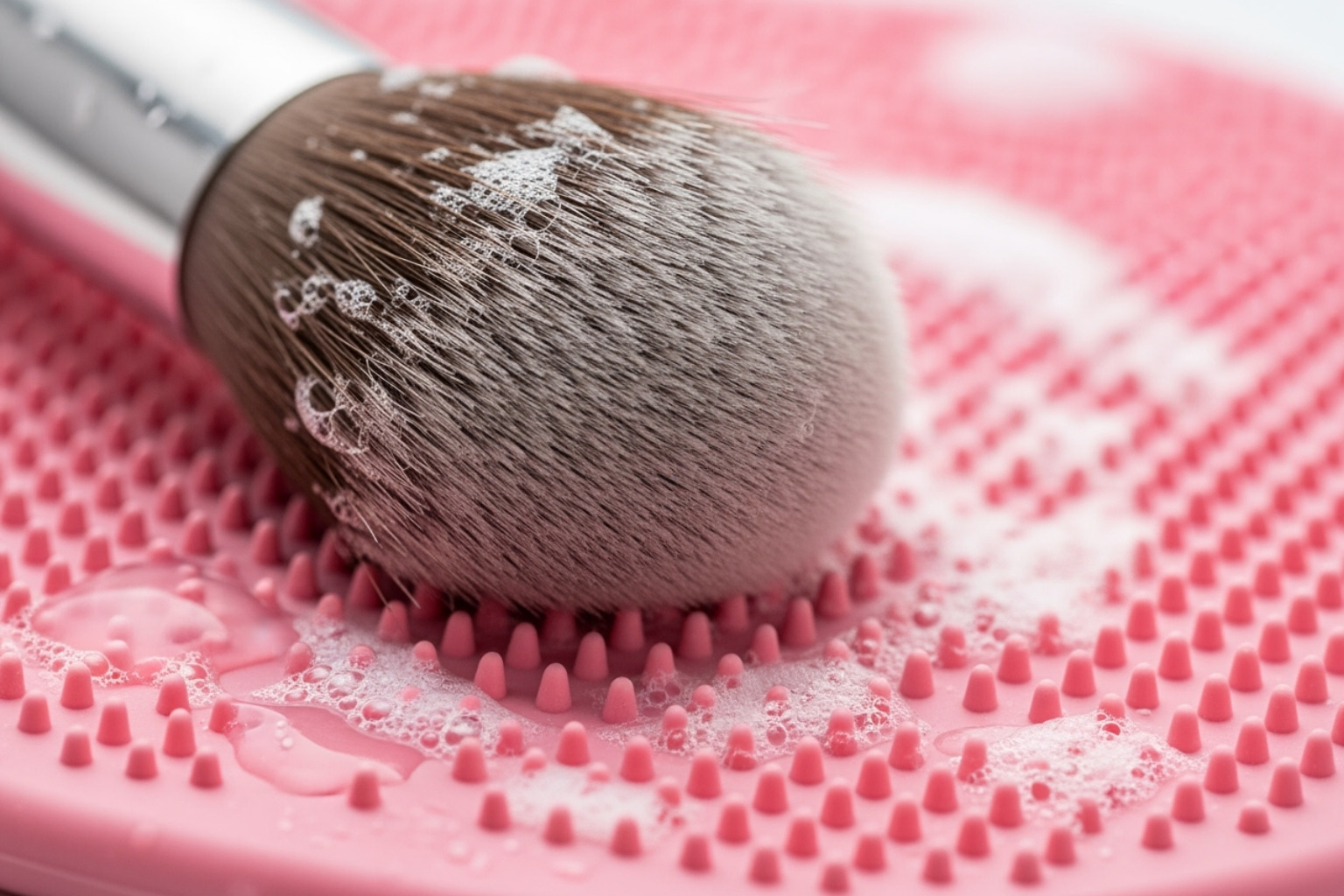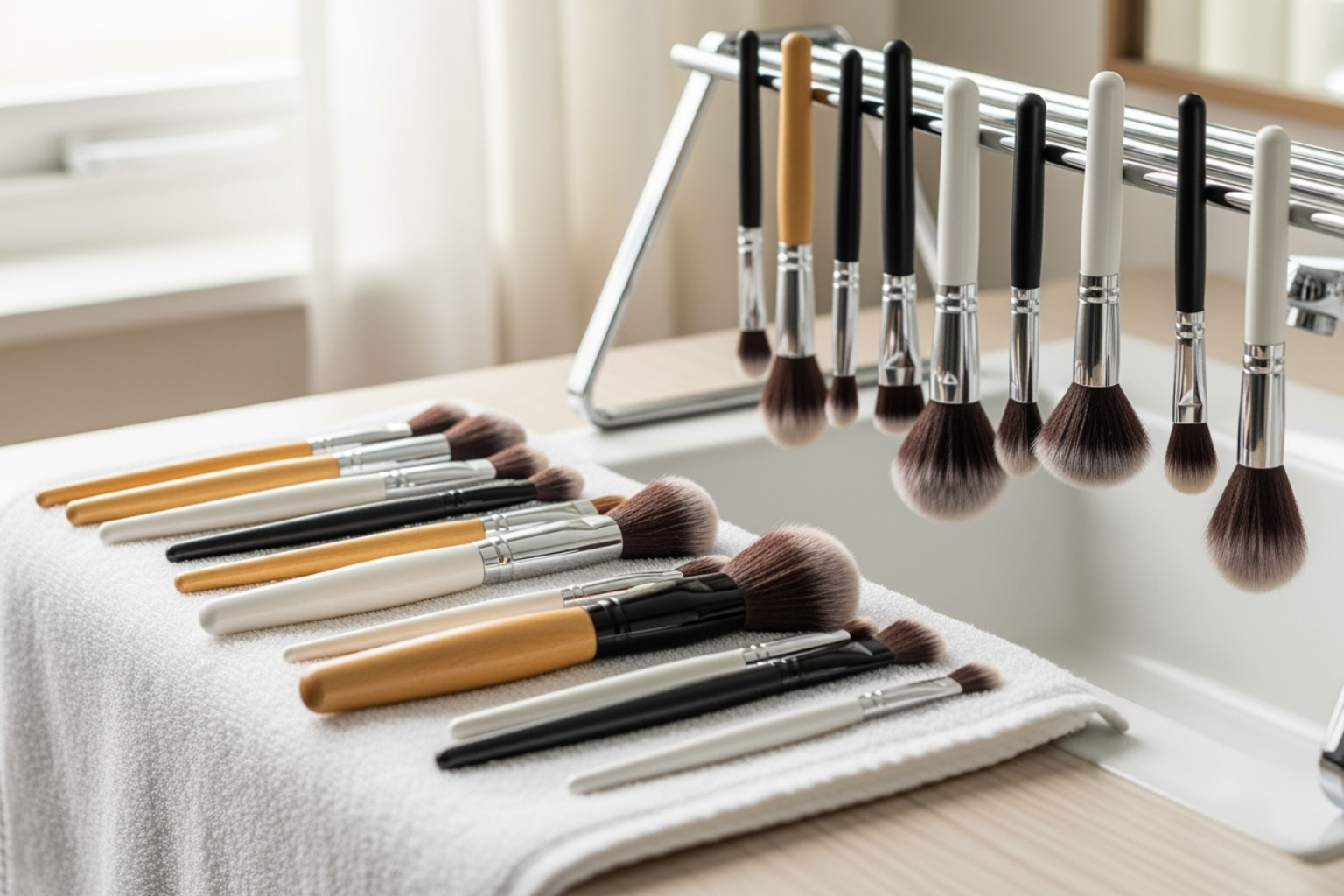Why Clean Makeup Brushes Matter for Your Skin and Beauty Routine
Clean makeup brushes are essential for healthy skin and flawless makeup application. Here’s what you need to know:
Quick Cleaning Guide:
- Foundation/concealer brushes: Clean weekly
- Eyeshadow/powder brushes: Clean every 2 weeks
- Lip brushes: Clean after every use
- Beauty sponges: Clean after each use, replace every 3 months
Basic cleaning method: Rinse bristles with lukewarm water, massage with gentle shampoo or castile soap, rinse until water runs clear, squeeze out excess water, and lay flat to dry.
If you’re like most people, cleaning your makeup brushes probably isn’t at the top of your self-care list. But here’s the truth: dirty brushes can become bacteria hotbeds that wreak havoc on your skin.
Research shows that unwashed makeup brushes can cause serious skin problems including acne breakouts, rashes, and even infections like E. coli or staph. The American Academy of Dermatology recommends washing your brushes every 7 to 10 days to protect your skin and kill harmful bacteria.
Beyond skin health, clean brushes give you better makeup results. When bristles are clogged with old product, oils, and bacteria, your foundation looks patchy and your eyeshadow won’t blend properly.
The good news? Cleaning your makeup brushes is simpler than you think. With just a few natural ingredients and the right technique, you can transform your dirty brushes into squeaky-clean tools that protect your skin and improve your natural glow.

Clean makeup brushes glossary:
Why a Clean Kit is a Skincare Non-Negotiable
Think about it: you spend time and money on the perfect skincare routine, carefully choosing products that work for your skin type. But if you’re applying makeup with dirty brushes, you might be undoing all that hard work.
Clean makeup brushes aren’t just about having tidy tools – they’re essential for healthy skin and flawless makeup application. When your brushes are loaded with old foundation, powder, and oils, they can’t pick up or blend new products properly. The result? Streaky coverage, patchy blush, and eyeshadow that refuses to cooperate.
But here’s where it gets serious: dirty brushes become breeding grounds for bacteria that can wreak havoc on your skin.
The Hidden Dangers Lurking in Dirty Brushes
Every time you use an unwashed brush, you’re reintroducing a cocktail of bacteria, dead skin cells, and old makeup back onto your face. This creates the perfect storm for skin problems.
Acne breakouts and clogged pores are often the first signs of trouble. Those mysterious pimples that keep appearing? Your dirty brushes might be the culprit. You’re essentially painting bacteria back onto freshly cleansed skin.
Skin irritation and rashes follow closely behind, especially for those with sensitive skin. The buildup of old products and bacteria can trigger redness, itching, and uncomfortable reactions.
The most concerning risk involves serious infections. Dirty makeup brushes can harbor dangerous bacteria like E. coli, staph, and fungal infections. These aren’t minor skin irritations – they can require medical treatment and cause lasting damage.
The American Academy of Dermatology strongly recommends cleaning your brushes every 7 to 10 days to kill harmful bacteria. You can find detailed guidance on how to clean your makeup brushes from trusted medical sources.
The Positive Side of Clean Brushes
Regular brush cleaning transforms your entire makeup routine. Improved makeup application becomes immediately noticeable – foundation glides on smoothly, colors blend effortlessly, and your overall look appears more polished and professional.
Clean brushes also mean longer brush lifespan. Proper care prevents bristles from breaking down, keeps them soft and flexible, and protects the ferrule (the metal part) from loosening. Quality brushes are an investment, and regular cleaning helps them last for years.
Your makeup products stay fresher longer too. Dirty brushes can contaminate your powders, foundations, and eyeshadows, shortening their shelf life and potentially making them unsafe to use.
Making clean makeup brushes part of your regular routine is like adding an extra layer of protection to your skincare regimen. It’s a simple step that prevents problems before they start and keeps your skin looking its best.
For more ways to maintain healthy, glowing skin, check out our comprehensive guide on Beauty Tips for Clear and Glowing Skin.
The Ultimate Guide to Clean Makeup Brushes
Let’s be honest – cleaning makeup brushes might not be the most exciting part of your beauty routine, but it’s definitely one of the most rewarding. Once you get into the groove, it becomes a satisfying ritual that’s as relaxing as it is beneficial for your skin.
Think of brush cleaning like doing laundry for your beauty tools. Just as we have different washing methods for delicate silk versus sturdy denim, our brushes need different approaches too. Deep cleaning is your thorough, weekly wash-day equivalent – a complete cleanse with water and soap that removes every trace of makeup, oil, and bacteria. Spot cleaning, on the other hand, is like using a stain remover pen – a quick surface cleanse between uses or when switching between eyeshadow colors.
The material of your brushes also matters. Natural bristles (made from animal hair) are more delicate and need gentler treatment, while synthetic bristles can handle slightly more robust cleaning methods. Understanding these differences will help you give each brush exactly what it needs to stay in top condition.

What You’ll Need to Clean Makeup Brushes
Good news – you probably already have most of what you need for clean makeup brushes sitting in your bathroom or kitchen right now! This makes brush cleaning both budget-friendly and super accessible.
The star of your cleaning arsenal is a gentle soap or cleanser. Baby shampoo is a favorite among makeup artists because it’s formulated to be extra gentle, making it perfect for both natural and synthetic bristles. Look for sulfate-free and fragrance-free versions if you have sensitive skin. Castile soap is another fantastic option – this plant-based, biodegradable soap cuts through makeup residue without harsh chemicals, plus it’s environmentally friendly.
Your regular gentle facial cleanser works beautifully too. If it’s safe for your face, it’s generally safe for your brushes. Just avoid anything with scrubbing beads or harsh exfoliants. Some people swear by simple bar soaps like Dove or Ivory, especially for deep cleaning stubborn foundation buildup.
Lukewarm water is crucial – never use hot water! Hot water can weaken the glue holding your brush head to the handle, leading to a sad, shedding brush. Think of it like washing your hair – you want it warm enough to be effective but not so hot that it damages.
A silicone cleaning mat with ridges and textures helps agitate the bristles and dislodge stubborn makeup. Don’t have one? No problem – the palm of your hand works just as well! You’ll also need a clean towel for blotting and drying.
For those who love DIY solutions, your kitchen pantry holds some brush-cleaning gold. White vinegar makes an excellent natural disinfectant for a final sanitizing rinse. Baking soda helps fight bacteria with its alkaline properties. Dish soap works wonders on synthetic brushes, especially those used with liquid products, though it can be too drying for natural bristles.
Natural oils like olive, coconut, or jojoba oil are fantastic for breaking down stubborn oil-based makeup before you wash with soap. They also help condition natural bristles. A few drops of tea tree oil in your cleaning solution adds natural antibacterial power, and witch hazel works great in DIY spray cleaners.
With these supplies ready, you’re all set to transform your makeup tools. If you’re looking to upgrade your brush collection, quality tools like our EcoFriendly Bamboo Makeup Brushes Set respond beautifully to regular cleaning and last for years.
The Step-by-Step Deep Cleaning Method
Now for the satisfying part – watching all that makeup residue swirl down the drain! This deep cleaning method ensures every trace of old makeup, oil, and bacteria disappears, leaving you with perfectly clean brushes.

Start by wetting the bristles carefully. Hold your brush with bristles pointing downward under lukewarm running water. This is super important – you only want to wet the bristles, not the metal ferrule or handle. Water seeping into the ferrule can dissolve the glue, causing your brush to shed like a golden retriever in summer!
Next, apply your cleanser to the palm of your hand, a silicone mat, or a small bowl. For brushes caked with heavy foundation or concealer, try swirling them in a tiny bit of olive oil first to break down the product before adding soap.
Lather and swirl gently in circular motions. You’ll see the lather form and watch in satisfaction as the makeup starts coming off. Be gentle here – no aggressive scrubbing! Think of it like massaging shampoo into your hair rather than scrubbing a dirty pot.
Rinse thoroughly with the bristles still pointing downward. Keep rinsing until the water runs completely clear and no soap suds remain. This might take several rounds of swirling and rinsing, especially for heavily used brushes. Don’t rush this step – leftover soap can irritate your skin later.
Squeeze out excess water gently with your fingers or a clean paper towel. Avoid twisting or wringing the bristles, which can damage their shape and structure.
While the bristles are still damp, reshape the brush head to its original form. This step is like styling wet hair – it sets the shape as it dries.
For natural hair brushes, consider adding a conditioning step. After rinsing out the soap, apply a tiny amount of hair conditioner, massage it in for about a minute, then rinse thoroughly. This keeps natural bristles soft and prevents them from becoming brittle.
Following these steps gives you clean makeup brushes that aren’t just visibly spotless, but deeply sanitized and ready to perform their best.
How to Properly Dry and Store Your Brushes
Here’s where many people go wrong – the drying and storage phase is just as crucial as the washing itself. Get this right, and your brushes will last for years. Get it wrong, and you might end up with moldy, damaged tools.

The golden rule for drying is simple: lay flat or hang bristles down. This prevents water from draining into the ferrule and weakening the glue.
Laying flat is the easiest method. Place your clean, reshaped brushes on a clean towel with the bristles hanging slightly over the edge of a counter. This allows air to circulate around the entire brush head, speeding up drying time. Feel free to turn them occasionally for even drying.
Hanging bristles down is even better if you can manage it. Some people get creative with rubber bands and clothes hangers, or even tape brushes to a wall temporarily. Gravity helps pull water away from the ferrule, which is exactly what we want.
Never, ever dry your brushes standing upright in a cup while they’re wet. This is like storing a wet umbrella upside down – all that water drains right where you don’t want it, into the ferrule. This creates the perfect environment for mildew and loosens the glue holding your brush together.
Avoid heat sources like hair dryers, direct sunlight, or radiators. High heat can damage bristles, melt glue, and warp brush shapes. Be patient – natural air drying takes 6 to 12 hours depending on brush density and humidity, but it’s worth the wait.
Once your brushes are completely dry, you can use brush guards (those mesh sleeves) to maintain their shape, especially for fluffy powder brushes. For everyday storage, keep your dry brushes upright in a holder or breathable case to protect their shape and keep them clean.
Proper drying and storage doesn’t just keep your clean makeup brushes hygienic – it extends their lifespan significantly. This aligns perfectly with Sustainable Beauty Practices by making your beauty tools last for years instead of months.
Your Cleaning Schedule: How Often is Enough?
“How often should I clean my makeup brushes?” This is a question we hear all the time, and it’s a really important one! There’s no one-size-fits-all answer, as it depends on the type of brush and how often you use it. But here’s a general golden rule to keep in mind: aim to wash your brushes at least every 7 to 10 days. This helps keep those pesky bacteria at bay and protects your beautiful skin.
Let’s start with the brushes that work hardest: your foundation and concealer brushes. These tools get up close and personal with liquid and cream products, plus the natural oils from your skin. This makes them a perfect hangout spot for bacteria! To prevent product buildup, clogged pores, and unwelcome breakouts, give these brushes a good deep clean at least once a week. It’s a small step that makes a huge difference for your complexion.
Next up are your eyeshadow, powder, blush, and bronzer brushes. While they might not deal with as much moisture as liquid product brushes, they still gather makeup residue, dead skin cells, and even dust from the air. For your eyeshadow and powder brushes, a thorough wash every two weeks is usually perfect. This keeps your color application pure and helps avoid any irritation. If you’re someone who uses the same eyeshadow brush for different shades, a quick spot clean between colors can prevent your look from getting ‘muddy.’ For your blush and bronzer brushes, a good clean once a month is often enough, unless you use them daily with cream products or find yourself breaking out more often.
Now, for the really personal tools: your lip brushes and beauty sponges/blenders. Your lip brush comes into contact with your mouth (which, let’s be honest, has its fair share of bacteria!) and often sticky lip products. So, make it a habit to clean your lip brushes after every single use. It’s just like rinsing your toothbrush! As for those beloved beauty sponges and blenders, they soak up a lot of liquid product and moisture, making them prime real estate for bacteria to grow. This means they need to be washed after every single use. And because they’re so porous, even with diligent cleaning, it’s a good idea to replace them every three months.
Beyond these deep cleaning schedules, there’s a secret weapon to keeping your brushes fresh: daily spot cleaning. Think of it as a quick rinse for your brushes after each use. While it doesn’t replace a deep clean, a quick spray with a brush cleaning solution and a wipe on a clean towel can remove surface product and lightly sanitize your brushes. This helps prevent heavy buildup and keeps your clean makeup brushes performing their best between those deeper washes.
How do you know it’s really time for a brush bath, even if you’re trying to stick to a schedule? Your brushes will tell you! Look closely: if you can see makeup caked on the bristles, it’s definitely time. If your makeup looks streaky, patchy, or just won’t blend like it used to, dirty brushes are often the culprit. And if your brush has an ‘off’ odor that just won’t go away, that’s a big sign of bacteria growth – time for an immediate deep clean! Lastly, if you’re experiencing unexplained breakouts or skin irritation, don’t overlook your brushes; they might be the hidden cause.
Getting into the habit of this cleaning schedule might feel like an extra task at first, but trust us, it quickly becomes a satisfying part of your beauty routine. Many find that setting aside some time on a Sunday evening to clean their brushes leaves them feeling ready to start the week with a fresh, clean makeup brushes set, perfect for achieving that Fresh Natural Makeup Look!
Frequently Asked Questions about Cleaning Makeup Brushes
We’ve covered the why and the how, but there are always more questions when it comes to keeping our beauty tools pristine. Let’s explore some of the most common questions we get about maintaining clean makeup brushes.
What household items can I use to clean my brushes?
The beauty of brush cleaning is that we don’t need fancy, expensive products to get amazing results. Our kitchen and bathroom cabinets are treasure troves of effective, budget-friendly cleaning solutions!
White vinegar is our secret weapon for natural disinfection. Mix two tablespoons with a cup of warm water for a powerful antibacterial rinse. Don’t worry about the smell – it disappears completely as the brushes dry. Adding a squeeze of fresh lemon juice brightens the bristles and leaves them looking like new.
For a deep-cleaning powerhouse, baking soda works wonders. Its alkaline nature (pH of 8.3) creates an environment where bacteria simply can’t thrive. Mix a teaspoon into a glass of room-temperature water and let your brushes soak for about 20 minutes. You’ll be amazed at how this simple solution tackles even stubborn buildup.
Dish soap deserves special mention for synthetic brushes, especially those used with heavy foundations or concealers. Its grease-cutting power is best for breaking down oil-based products. However, save this powerhouse for synthetic bristles only – natural hair brushes need gentler treatment to avoid damage.
Here’s a game-changer: olive oil as a pre-treatment. Before reaching for soap, swirl heavily soiled brushes in a small amount of olive or coconut oil. This dissolves stubborn makeup, making the actual washing process much more effective. Think of it as a makeup remover for your brushes!
Using these everyday items perfectly aligns with maintaining a Zero Waste Beauty Routine by making the most of what we already have at home.
Is there a difference in cleaning natural vs. synthetic brushes?
Absolutely! Just like we wouldn’t wash a cashmere sweater the same way we’d wash denim, different brush materials need different approaches to stay in top condition.
Natural hair brushes are made from animal hair like goat, squirrel, or sable. These brushes have cuticles similar to our own hair, which means they can absorb oils and products. They’re incredible for powder products but need tender loving care.
Think of natural bristles as delicate hair that needs pampering. Gentle cleansers like baby shampoo, mild facial cleanser, or castile soap are perfect choices. Harsh soaps or strong chemicals will strip their natural oils, leaving them dry, brittle, and prone to shedding – nobody wants that!
Here’s where it gets interesting: natural bristles actually benefit from conditioning. After rinsing out the soap, work a tiny amount of hair conditioner through the bristles for about a minute, then rinse thoroughly. This keeps them soft, flexible, and performing beautifully for years.
Synthetic bristles, made from man-made fibers like nylon or Taklon, are the workhorses of the brush world. They’re perfect for liquid, cream, and gel products because they don’t absorb product – they just move it around exactly where we want it.
The great news about synthetic brushes is their durability. They can handle more robust cleaning methods, including that dish soap we mentioned earlier. Since they don’t have cuticles, there’s no need for conditioning – just clean, rinse, and they’re ready to go.
Understanding these differences ensures our clean makeup brushes stay in perfect condition, regardless of whether they’re natural or synthetic.
When is it time to replace my makeup brushes?
Even with the most loving care and regular cleaning, our trusty brushes won’t last forever. Knowing when to retire them is crucial for both hygiene and getting that flawless makeup application we’re after.
Excessive shedding is usually the first sign it’s time to say goodbye. If your brush leaves a trail of bristles on your face or in your makeup bag every time you use it, the glue holding everything together is giving up. This affects application quality and, frankly, picking hairs off your face gets old fast.
When a brush loses its shape and won’t bounce back even after washing and reshaping, it’s lost its ability to do its job properly. A splayed foundation brush won’t give you that smooth, even coverage, and a flat eyeshadow brush won’t blend colors the way it should.
Here’s a red flag that should never be ignored: a lingering smell that persists even after thorough cleaning and complete drying. This means bacteria has embedded itself so deeply that no amount of washing will eliminate it. Trust your nose on this one – it’s time for a replacement.
Frayed bristles that feel rough or scratchy against your skin are another clear signal. Not only will they irritate your skin, but they’ll also create patchy, uneven makeup that looks anything but professional.
Sometimes it’s just about general wear and tear. Loose handles, wobbly ferrules, or brushes that simply feel “tired” and don’t perform like they used to are all signs that they’ve served their purpose well and deserve retirement.
For timeline guidance, powder brushes typically last 2-3 years with proper care, while liquid product brushes usually need replacing after 1-2 years due to more intensive cleaning requirements. Beauty sponges are the exception – replace them every three months regardless of how well you clean them, due to their porous nature and high potential for bacterial growth.
Trust your instincts here. If a brush feels off, performs poorly, or gives you any hygiene concerns, it’s better to replace it. Your skin and your makeup application will definitely thank you for the upgrade.
Conclusion
Taking care of our clean makeup brushes might seem like a small detail in our beauty routine, but as we’ve finded, it’s actually one of the most impactful changes we can make. Think about it – we spend so much time and money on skincare products and makeup, yet many of us overlook the very tools that deliver these products to our skin.
The journey we’ve taken together shows just how transformative this simple habit can be. When we commit to regular brush cleaning, we’re doing so much more than maintaining our tools. We’re actively protecting our skin from harmful bacteria that can cause breakouts, irritation, and even serious infections. We’re ensuring our makeup applies beautifully every single time, with colors that stay true and blending that looks effortless.
There’s something deeply satisfying about seeing those dirty brushes transform into pristine tools again. It’s like giving our beauty routine a fresh start. Plus, when we take proper care of our brushes, they reward us by lasting years longer than neglected ones. That’s not just good for our wallet – it’s better for the planet too.
Clean makeup brushes represent something bigger than hygiene. They’re a symbol of self-care, of taking the time to do things properly, and of respecting both our skin and our investment in quality tools. It’s these small, consistent acts of care that add up to make a real difference in how we look and feel.
At Beyond Beauty Lab, we’re passionate about empowering you with knowledge that makes a genuine difference. Whether it’s understanding ingredients, mastering techniques, or simply knowing how to care for your tools properly, we believe that education is the foundation of true beauty and wellness.
Ready to continue your clean beauty journey with us? Explore more clean beauty products and find how small changes can create beautiful results, inside and out.







